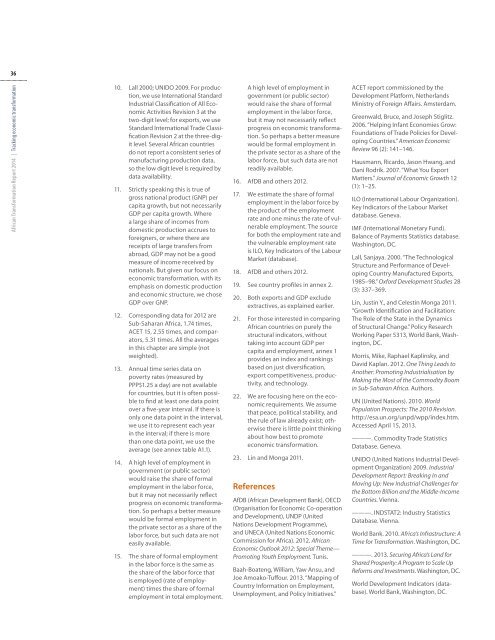2014-african-transformation-report
2014-african-transformation-report
2014-african-transformation-report
Create successful ePaper yourself
Turn your PDF publications into a flip-book with our unique Google optimized e-Paper software.
36African Transformation Report <strong>2014</strong> | Tracking economic <strong>transformation</strong>10. Lall 2000; UNIDO 2009. For production,we use International StandardIndustrial Classification of All EconomicActivities Revision 3 at thetwo-digit level; for exports, we useStandard International Trade ClassificationRevision 2 at the three-digitlevel. Several African countriesdo not <strong>report</strong> a consistent series ofmanufacturing production data,so the low digit level is required bydata availability.11. Strictly speaking this is true ofgross national product (GNP) percapita growth, but not necessarilyGDP per capita growth. Wherea large share of incomes fromdomestic production accrues toforeigners, or where there arereceipts of large transfers fromabroad, GDP may not be a goodmeasure of income received bynationals. But given our focus oneconomic <strong>transformation</strong>, with itsemphasis on domestic productionand economic structure, we choseGDP over GNP.12. Corresponding data for 2012 areSub- Saharan Africa, 1.74 times,ACET 15, 2.55 times, and comparators,5.31 times. All the averagesin this chapter are simple (notweighted).13. Annual time series data onpoverty rates (measured byPPP$1.25 a day) are not availablefor countries, but it is often possibleto find at least one data pointover a five-year interval. If there isonly one data point in the interval,we use it to represent each yearin the interval; if there is morethan one data point, we use theaverage (see annex table A1.1).14. A high level of employment ingovernment (or public sector)would raise the share of formalemployment in the labor force,but it may not necessarily reflectprogress on economic <strong>transformation</strong>.So perhaps a better measurewould be formal employment inthe private sector as a share of thelabor force, but such data are noteasily available.15. The share of formal employmentin the labor force is the same asthe share of the labor force thatis employed (rate of employment)times the share of formalemployment in total employment.A high level of employment ingovernment (or public sector)would raise the share of formalemployment in the labor force,but it may not necessarily reflectprogress on economic <strong>transformation</strong>.So perhaps a better measurewould be formal employment inthe private sector as a share of thelabor force, but such data are notreadily available.16. AfDB and others 2012.17. We estimate the share of formalemployment in the labor force bythe product of the employmentrate and one minus the rate of vulnerableemployment. The sourcefor both the employment rate andthe vulnerable employment rateis ILO, Key Indicators of the LabourMarket (database).18. AfDB and others 2012.19. See country profiles in annex 2.20. Both exports and GDP excludeextractives, as explained earlier.21. For those interested in comparingAfrican countries on purely thestructural indicators, withouttaking into account GDP percapita and employment, annex 1provides an index and rankingsbased on just diversification,export competitiveness, productivity,and technology.22. We are focusing here on the economicrequirements. We assumethat peace, political stability, andthe rule of law already exist; otherwisethere is little point thinkingabout how best to promoteeconomic <strong>transformation</strong>.23. Lin and Monga 2011.ReferencesAfDB (African Development Bank), OECD(Organisation for Economic Co- operationand Development), UNDP (UnitedNations Development Programme),and UNECA (United Nations EconomicCommission for Africa). 2012. AfricanEconomic Outlook 2012: Special Theme—Promoting Youth Employment. Tunis.Baah-Boateng, William, Yaw Ansu, andJoe Amoako-Tuffour. 2013. “Mapping ofCountry Information on Employment,Unemployment, and Policy Initiatives.”ACET <strong>report</strong> commissioned by theDevelopment Platform, NetherlandsMinistry of Foreign Affairs. Amsterdam.Greenwald, Bruce, and Joseph Stiglitz.2006. “Helping Infant Economies Grow:Foundations of Trade Policies for DevelopingCountries.” American EconomicReview 96 (2): 141–146.Hausmann, Ricardo, Jason Hwang, andDani Rodrik. 2007. “What You ExportMatters.” Journal of Economic Growth 12(1): 1–25.ILO (International Labour Organization).Key Indicators of the Labour Marketdatabase. Geneva.IMF (International Monetary Fund).Balance of Payments Statistics database.Washington, DC.Lall, Sanjaya. 2000. “The TechnologicalStructure and Performance of DevelopingCountry Manufactured Exports,1985–98.” Oxford Development Studies 28(3): 337–369.Lin, Justin Y., and Celestin Monga 2011.“Growth Identification and Facilitation:The Role of the State in the Dynamicsof Structural Change.” Policy ResearchWorking Paper 5313, World Bank, Washington,DC.Morris, Mike, Raphael Kaplinsky, andDavid Kaplan. 2012. One Thing Leads toAnother: Promoting Industrialisation byMaking the Most of the Commodity Boomin Sub- Saharan Africa. Authors.UN (United Nations). 2010. WorldPopulation Prospects: The 2010 Revision.http://esa.un.org/unpd/wpp/index.htm.Accessed April 15, 2013.———. Commodity Trade StatisticsDatabase. Geneva.UNIDO (United Nations Industrial DevelopmentOrganization) 2009. IndustrialDevelopment Report: Breaking In andMoving Up: New Industrial Challenges forthe Bottom Billion and the Middle-IncomeCountries. Vienna.———. INDSTAT2: Industry StatisticsDatabase. Vienna.World Bank. 2010. Africa’s Infrastructure: ATime for Transformation. Washington, DC.———. 2013. Securing Africa’s Land forShared Prosperity: A Program to Scale UpReforms and Investments. Washington, DC.World Development Indicators (database).World Bank, Washington, DC.


